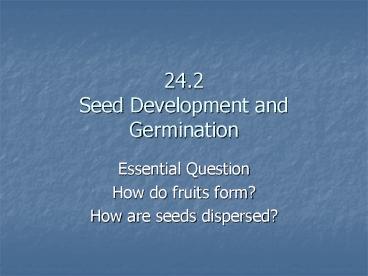24.2 Seed Development and Germination - PowerPoint PPT Presentation
1 / 17
Title:
24.2 Seed Development and Germination
Description:
24.2 Seed Development and Germination Essential Question How do fruits form? How are seeds dispersed? Seed and Fruit Development After fertilization, nutrients flow ... – PowerPoint PPT presentation
Number of Views:1672
Avg rating:3.0/5.0
Title: 24.2 Seed Development and Germination
1
24.2 Seed Development and Germination
- Essential Question
- How do fruits form?
- How are seeds dispersed?
2
Seed and Fruit Development
- After fertilization, nutrients flow into the
flower tissue and support the development of the
growing embryo within the seed. - As angiosperms seeds mature, the ovary walls
thicken to form a fruit that encloses the
developing seeds - A fruit is a ripened ovary that contains
angiosperm seeds.
3
Figure 24-10
4
Contd
- Parts of the ovule toughen to form the a seed
coat, which is the outer layer of that protects
the delicate embryo and its food supply - The ovary wall thickens and may join with other
parts of the flower stem - The structures together form a fruit that
encloses the seeds.
5
(No Transcript)
6
Seed Parts 1. Embryo the zygote, which is
a tiny plant inside the covering. 2.
Cotyledons one or two seed leaves which store
food for growth. 3. Seed Coat keeps it from
drying out (some last thousands of years).
7
The Structure of Seeds
8
Seed Dispersal
- The endosperm nourishes the seedling NOT the
fruit - Seeds spread by animals are contained in fruit
that entices them to eat it and thus spreads the
seeds - Animals include insects, birds, and mammals
- Seeds spread by the wind and water tend to be
lightweight - Seeds spread by animals is more efficient than
seeds spread by the wind.
9
Seed Dispersal Methods
10
(No Transcript)
11
Seed Dormancy
- Dormancy - seed is alive but not growing
- Environmental factors such as temperature and
moisture can cause a seed to end its dormancy and
germinate - Adaptive for plant by allowing for long-distance
dispersal, temperature extremes
12
Seed Germination
- Germination - early growth stage of plant embryo
- Early seeds absorb water causing food-storage to
swell, cracking open the seed coat. - The young root begins to grow and the seed leaves
(cotyledon) emerges - Monocot one seed leaf
- Dicot two seed leaves
13
Monocot vs. dicot
14
Figure 24-14
15
Monocot Seed Germination
- Monocots grow straight up with coleoptile sheath
covering shoot - One embryonic leaf
- Seed remains underground
16
Dicot Seed Germination
- Curved stem comes up out of soil
- Two embryonic leaves
- Seed goes above soil
17
Parts of the Embryo
- Epicotyl - Grows into the leaves of the plant
- Hypocotyl - Becomes the stem
- Radicle - Becomes the root

